Choosing the Right Ergonomic Office Chair for Your Workspace
In today’s fast-paced work environment, the importance of ergonomics cannot be overstated. An ergonomic office chair is essential for promoting comfort and productivity while minimizing health risks associated with prolonged sitting. This article will guide you through the essential factors to consider when choosing the right ergonomic office chair for your workspace.
Understanding Ergonomics
Ergonomics is the science of designing a workspace that fits the user’s needs, thus enhancing comfort and efficiency. Poor ergonomics can lead to a range of health issues, including musculoskeletal disorders, chronic pain, and decreased productivity.
Why Invest in an Ergonomic Office Chair?
Investing in an ergonomic office chair is not just about comfort; it’s about overall well-being and productivity. Here are some key reasons why you should consider making this investment:
- Reduces Pain: An ergonomic chair is designed to support the natural curve of your spine, reducing back pain and discomfort.
- Improves Posture: These chairs encourage proper posture, which can prevent long-term health complications.
- Enhances Productivity: Comfortable employees are more focused and engaged, leading to increased productivity.
- Long-term Savings: Investing in a quality ergonomic chair can reduce healthcare costs associated with workplace injuries.
Key Features to Look for in an Ergonomic Office Chair

When shopping for an ergonomic office chair, there are several features you should consider to ensure that it meets your needs:
1. Adjustability

One of the most critical aspects of an ergonomic chair is its adjustability. A good office chair should allow you to customize the following:
- Seat Height: The seat should adjust so that your feet can rest flat on the floor.
- Backrest Angle: The backrest should recline to support your back while allowing for movement.
- Armrest Height: Armrests should be adjustable to support your arms without causing shoulder strain.
- Seat Depth: The seat should allow you to sit back comfortably while maintaining a few inches between the edge of the seat and the back of your knees.
2. Lumbar Support

Proper lumbar support is crucial in preventing lower back pain. Look for chairs with:
- Adjustable Lumbar Support: This feature allows you to move the lumbar support up or down to fit your spine’s natural curve.
- Contoured Backrests: These can provide additional support to the lower back, helping to maintain good posture.
3. Material and Padding
The materials used in an office chair can significantly affect comfort. Consider the following:
- Breathable Fabrics: Chairs with mesh backs allow for airflow, reducing heat and moisture build-up during long hours of sitting.
- Quality Padding: Look for chairs with high-density foam or gel padding for better support and comfort.
4. Mobility
A good office chair should be easy to move around your workspace. Features to look for include:
- Swivel Base: A chair that swivels allows you to reach different areas of your workspace without straining.
- Caster Wheels: Opt for chairs with smooth-rolling wheels that are suitable for your floor type.
Case Studies and Statistics

The impact of ergonomic office chairs on workplace productivity has been highlighted in various studies. For instance, a study conducted by the Occupational Safety and Health Administration (OSHA) found that implementing ergonomic solutions, including office chairs, resulted in:
- A 30% reduction in musculoskeletal disorders.
- A 25% increase in productivity.
Another study published in the Journal of Occupational Rehabilitation found that employees who used ergonomic chairs reported a 50% decrease in discomfort during work hours.
Choosing the Right Chair for Your Needs
Every individual has unique needs when it comes to comfort and support. Here are some considerations to help you choose the right chair:
1. Assess Your Work Environment

Consider the nature of your work. If you spend long hours at your desk, prioritize comfort and support. For those who switch between standing and sitting, a chair with easy adjustability would be beneficial.
2. Understand Your Body Type
Different body types may require different types of support. Taller individuals may need chairs with a higher back and a longer seat depth, while shorter individuals may benefit from chairs with lower seat heights and adjustable lumbar support.
3. Test Before You Buy

Whenever possible, test chairs before purchasing. Spend a few minutes sitting in each chair to evaluate comfort, adjustability, and support. Pay attention to how well the chair accommodates your body and if you feel supported in all areas.
Choosing the right ergonomic office chair is a crucial investment in your health and productivity. By understanding the importance of ergonomics and the key features to look for, you can select a chair that meets your needs. Remember to consider adjustability, lumbar support, material, and mobility, and take the time to test chairs to find the perfect fit. With the right ergonomic office chair, you can create a more comfortable, productive workspace that promotes long-term health and well-being.


